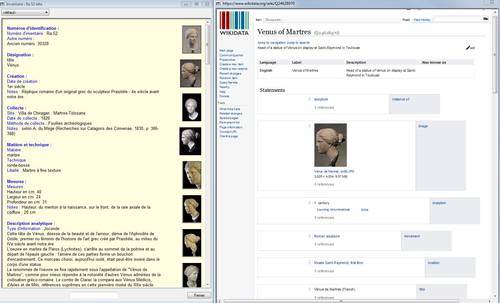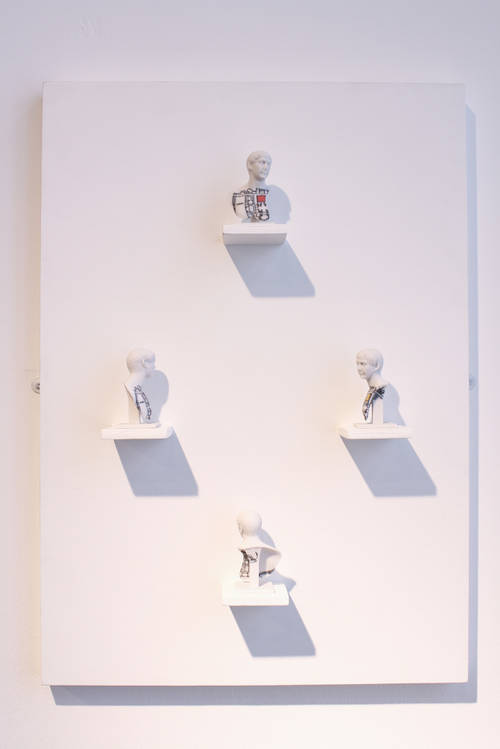Sharing archaeological cultural heritage: open data and Wikimedia projects at the Musée Saint-Raymond in Toulouse – Christelle Molinié (December 2018)
The Musée Saint-Raymond is the museum of archaeology of the city of Toulouse, in the south of France, located in a former medieval college next to the Saint-Sernin Basilica. With nearly 27,000 objects in its inventory, it is essentially known for the exceptional collection of Roman sculptures from the villa of Chiragan. While all collections are inventoried and computerized within the collection management software, we do not have our own portal. Some of the collections are gradually being published on the Joconde national portal, which lists the collections of French museums, and some artifacts are included in thematic databases specialized in archaeology NESP, Beazley, LIMC, Artefacts…etc.
Opening…
To distribute our collections and meet Toulouse Métropole’s open data policy, which began in 2011, the content and its metadata produced in the course of our activities or those whose rights have been transferred to us, have been placed under free licences (paternity,share alike and for all purposes). The inventory data are published in the form of data sets on the Toulouse Métropole open data platform. These raw data files, in spreadsheet format, are the result of an extraction from the collection management system. This database, created in the 1990s, suffers from a lack of structuring of its contents and the export of data has highlighted its lack of harmonization. Work on the recovery and consolidation of vocabularies has therefore proved necessary and the annual updating of the data sets will gradually improve their quality. The prospect of their reuse has led to a change in the way data and content are produced, we are now in a logic of capitalisation and recycling without being able to anticipate the uses of these contents that third parties may imagine.

1- Inventory record and Wikidata item linked within the collection management tool of the Musée Saint-Raymond
… for sharing
Well aware that the simple editing of CSV files is not enough to constitute an open data policy, we use free and open Wikimedia platforms to publish and share resources and thus practice true open content.
To this end, we initiate and encourage the creation of Wikipedia articles around collections written by team members or by external contributors during workshops. These articles are the result of the synthesis of the information contained in the objects paper files compiled by the documentation department.
The collections are also well represented on Wikimedia Commons. The photographs come either from the museum’s photo library, which makes regular payments, or from volunteer photographers whom we encourage to come and take pictures in the museum’s rooms or during temporary exhibitions and who thus help us to promote the collections.

2- The collections of the Saint-Raymond Museum present on Wikidata requested by the search engine Crotos
The 3D digitizations of arworks commissioned as part of the team’s activities and originally published on Sketchfab and those made by the Scan the World collective uploaded on My Mini Factory, are placed under the same CC BY-SA license. Thanks to this opening, the files could be imported on Wikimedia Commons in order to increase their visibility and link them to the Wikimedia ecosystem.
The metadata for the photographs comes from Wikidata, a structured knowledge base on which we gradually add our inventory data. Wikidata also offers the ability to aggregate all URLs of records on collections available in specialized databases. Each Wikidata element is linked to the corresponding internal inventory record, thus serving as a catalyst and a bridge between the different digital resources documenting the same object. Finally, Wikidata offers the opportunity to integrate collections into the web of data by benefiting from alignments and a model maintained by a community without having to acquire complex technical skills internally.
The implementation of this dual flow offers the advantage of enriching both our business tools and external platforms within an ecosystem at the service of collections and knowledge dissemination.
In addition to the ease of storage, the technical scalability of platforms and tools and the help of a community that cares about GLAM, investing in Wikimedia projects means benefiting from international visibility thanks to multilingualism and of course the popularity of platforms. What better place to work for cultural democratization?

3- Réutilisation du modèle 3D du buste de Trajan par Alice Martin
Bio :
Christelle Molinié has a dual training in documentation and art history, followed at the Ecole du Louvre. She has been working in the field of museum documentation for more than 15 years. At the end of 2016, she joined the team of the Musée Saint-Raymond, where she is managing the documentation resources. In addition, she contributes to Wikimedia projects and integrates them into her professional practices.